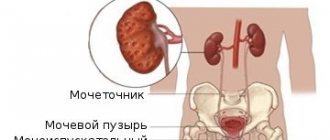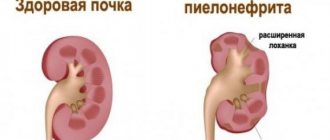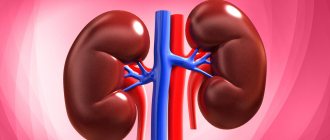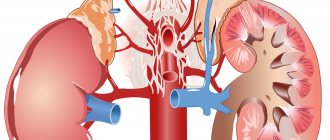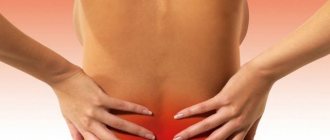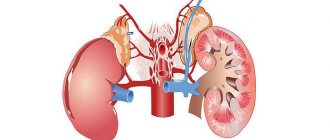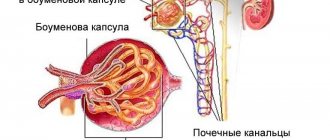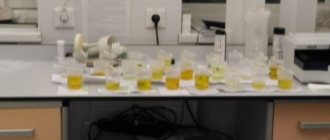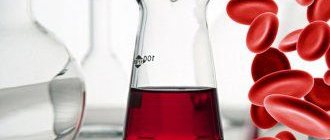Atherosclerosis of the renal arteries implies thickening of the walls and narrowing of the lumen of the renal arteries as a result of cholesterol deposits inside the vessel. In most cases it occurs in the form chronic disease, impairing blood supply to the kidneys. The main danger is the risk of renovascular symptomatic hypertension, which entails a threat to the patient’s life. In another case, chronic lack of blood supply can lead to the development of renal failure.
Risk factors include:
- elderly age;
- hereditary predisposition;
- smoking and alcohol;
- sedentary lifestyle;
- diabetes;
- excessive consumption of fatty and fried foods;
- overweight.
Factors influencing the development of atherosclerosis
Most often, atherosclerosis of the renal arteries occurs in people over 45 years of age. Men have the greatest predisposition to the development of this pathology.
Predisposing factors include:
- Being overweight;
- Abuse of fatty, fried foods;
- Inactive lifestyle;
- congenital kidney diseases;
- Presence of bad habits (smoking is especially harmful);
- Blood clotting disorder;
- Persistent increase in blood pressure;
- Hereditary predisposition;
- The presence of inflammatory processes developing in the kidney area;
- Gallstone disease;
- Diabetes mellitus type II;
- Hormonal imbalance;
- Nephrotic syndrome;
- Hypercholesterolemia;
- Non-standard arrangement of blood vessels in organs;
- Aging processes in the body.
The likelihood of developing this disease in women and men equalizes by age 50. Since at this age the production of estrogen decreases in the fair sex.
Stages of development
Atherosclerosis has several stages of development:
- The first stage is preclinical, asymptomatic. Any changes in the kidneys will be shown by a macropreparation only after special studies. Thus, arteriosclerosis can last up to several years.
- The second stage - at this stage, atherosclerotic plaques are formed, which gradually impede the passage of blood in the arteries. This stage is characterized by the formation of blood clots, since blood flow is significantly impaired. The kidneys suffer from a lack of oxygen.
- The third stage is the period of active development of complications. Kidney cells die and tissues undergo necrosis and are later replaced by scar tissue. The arteries of the organ are completely covered in atherosclerotic plaques. The kidney can no longer function normally. Kidney failure appears. The load on the heart increases, hypertension develops.
Symptoms of the disease
Atheroxlerosis of the renal arteries, the symptoms of which may be absent at the initial stage, is dangerous due to its complications. As the disease progresses, the following clinical signs are observed:
- Significant increase in blood pressure;
- Heaviness in the area of the visual organ;
- Feeling nauseous;
- Increase/decrease in body temperature;
- Redness of urine;
- Pain syndrome in the abdomen, back;
- Urinary dysfunction;
- General weakening of the body;
- Dizziness;
- Irritability;
- Impaired sleep quality;
- Swelling;
- Intense headaches;
- Skin itching;
- Vomiting attacks;
- Discomfort/pain in the chest area.
In this case, protein is detected in urine tests, and low levels of potassium are detected in the blood.
Lack of treatment can lead to a significant deterioration in kidney function, possibly developing renal failure, cerebral or coronary atherosclerosis.
When a renal artery aneurysm ruptures, the following symptoms occur:
- Sudden pain in the back or side of an increasing nature;
- Pallor of the skin;
- Increased heart rate.
There is also a decrease in blood pressure, as a result of which the patient may lose consciousness.
Causes of renal vascular pathology
Ischemic kidney disease can occur at any age, but young people almost never experience blockage of the renal arteries with atherosclerotic plaques. Possible causes of blood flow disturbances will be the following factors:
- abnormal location of the renal and perinephric vessels;
- congenital kidney pathology;
- changes in the blood coagulation system, provoking thrombosis in small and medium-sized arteries;
- inflammatory processes of blood vessels.
However, with age, atherosclerosis of the renal arteries takes first place among all causes of pathological blood flow. The main source of emboli is the abdominal aorta: from there, small and large lipid-cholesterol plaques of various sizes enter the vascular network of the urinary system. It is this factor that provides all the symptoms that significantly reduce a person’s quality of life. Treatment is primarily aimed at correcting metabolic disorders and restoring arterial blood flow.
It is very rare that isolated atherosclerotic processes occur, so most often ischemia of the renal structures is one of the types of vascular pathology in different parts of the body. A 50% narrowing of the lumen of the arterial trunks supplying the kidneys will always provoke the following manifestations and symptoms:
- arterial hypertension, treatment of which is often ineffective;
- deterioration of the vessels of the heart and brain with the formation of complicated variants of cardiac and cerebral atherosclerosis;
- development of interstitial nephritis (internal inflammation of the kidney tissue);
- the formation of chronic renal failure, in which the symptoms will be so mild that treatment can be started with a delay.
The main complaints that will arise in a person with atherosclerotic lesions of the renal vessels will be:
- pain of varying severity in the lumbar region or in the side on one side;
- surges in blood pressure, manifested by severe headaches, a pressing sensation in the heart and dizziness;
- the appearance of blood in the urine;
- various types of urination disorders.
The worst variant of the disease is acute ischemic nephropathy, when there is a sudden and massive blockage of the arteries with a large number of plaques. In this case, symptoms of acute renal failure quickly appear with a complete absence of urine and severe pain.
In each case, the doctor will look for the cause individually. However, if there are symptoms of atherosclerosis of any localization, then a specialist will definitely evaluate the condition of the renal vessels, even in the absence of complaints and changes in tests.
Possible consequences
Atherosclerosis of the renal vessels can lead to renovascular hypertension due to damage to the arteries and disruption of blood flow in them. The disease is extremely difficult to treat. The pathology develops rapidly and can cause a stroke or heart attack.
Atherosclerosis can cause a pathological enlargement of one section of the renal artery (aneurysm). If it ruptures, acute blood loss and hemorrhagic shock occur. In most cases (70%) death is likely. To save the patient's life, surgery is necessary.
Renal failure may occur due to impaired circulation and significant narrowing of the lumen of the vessel. This condition is characterized by a malfunction of the urinary system, as a result of which the water-salt balance is disrupted.
Lack of treatment can result in death.
Prognosis and possible complications
With proper treatment of the pathology and if the patient follows all the recommendations of the attending physician, the prognosis is generally favorable. However, if the disease starts and is not treated, sooner or later the patient will suffer a stroke, heart attack, or chronic renal failure. All these consequences lead to death in 60% of cases.
Important:
If the operation is performed correctly, the prognosis for the patient is favorable in 80% of cases.
Diagnostic procedures
To establish a diagnosis, it is necessary to visit a therapist, who, first of all, visually examines the patient, measures his blood pressure and BMI, and collects an anamnesis. Then the patient is sent for laboratory tests:
- Complete blood count (OAK);
- Blood chemistry;
- Urinalysis (OAM).
To identify atherosclerosis of the kidneys, the following examination methods are used:
- Dopplerography;
- Ultrasound examination (ultrasound) of the kidneys;
- Magnetic resonance imaging (MRT);
- Renal angiography and scintigraphy.
A complete diagnosis will help the attending physician establish an accurate diagnosis and prescribe appropriate treatment.
Diagnostics
The primary diagnosis is carried out by the therapist directly upon seeing the patient. Taking an anamnesis and visual examination helps him with this. Considerable importance is given to establishing the facts of disease risk, for example, measuring BMI, pressure indicators, etc.
Among the instrumental methods used to clarify the primary diagnosis are:
- MRI. Helps accurately visualize the presence and location of plaques and gives an idea of the condition of the vascular wall.
- EchoCG. Often carried out in combination with ultrasound, special stress tests are also used.
- Intravascular ultrasound, angiography, coronary angiography, other invasive techniques.
- Triplex and duplex scanning. Using techniques, vessels are visualized and blood flow speed is determined.
- Renal scintigraphy.
- Renal angiography.
Therapeutic measures
Therapy for atherosclerosis of renal vessels should be comprehensive and include:
- Significant nutritional correction;
- Getting rid of bad habits;
- Moderate physical activity;
- The use of medications to reduce cholesterol levels in the blood and stabilize blood pressure;
- Use of folk remedies.
In addition, the doctor may resort to surgical treatment, which will restore blood flow in the affected area.
The goal of treatment is to:
- Restoring kidney function;
- Prevention of serious complications;
- Reducing blood cholesterol levels;
- Elimination of atherosclerotic deposits on the walls of blood vessels;
- Preventing the formation of blood clots;
- Strengthening blood vessels, increasing their elasticity;
- Normalization of the urinary system.
To achieve the best result, you must strictly follow all doctor's instructions.
Lifestyle correction
A patient diagnosed with atherosclerosis needs to understand that changes in his own lifestyle must be radical. A diet for several weeks, one-time attempts at physical activity will not bring significant results. Only regular care of one’s own health and a conscious understanding of certain limitations will become the basis for the treatment of atherosclerosis.
A patient with atherosclerotic changes in the arteries (including renal) needs the following.
- Quit smoking (including passive smoking).
- Normalize weight through physical activity and a low-calorie diet.
- Limit the amount of carbohydrates and reduce the content of table salt, while the daily intake of protein ingredients should be increased.
- Table No. 8 (10) according to M.I. Pevzner should be a priority for a long time, or rather for life.
- Engage in feasible physical activity within reasonable limits.
These general points will not be able to bring the desired positive effect without drug therapy.
Diet for atherosclerosis of the renal arteries
An important role in the treatment of the pathology in question is played by special dietary nutrition (especially at the initial stage of development). To improve the absorption of food, you need to eat often, portions should be small.
Prepare dishes by steaming, boiling or baking. It is recommended to minimize salt intake.
The presence of atherosclerosis of the renal vessels suggests inclusion in the diet:
- Fruit;
- Bran;
- Berries;
- Seafood;
- Orekhov;
- Vegetables;
- Lean meat/fish;
- Poultry meat without skin;
- Low-fat fermented milk products;
- Natural honey;
- Dried fruits.
Butter can be replaced with any vegetable oil, but this product cannot be used for frying foods. You should control your drinking regime. The daily norm of purified drinking water is 1.5 - 2 liters. Among additional drinks, you should give preference to herbal tea, compotes, fruit drinks, and freshly pressed juices.
However, excessive fluid intake can lead to swelling.
Also, if you have this disease, you should stop consuming:
- Livestock products;
- Fatty, fried foods;
- Offal;
- Salinities;
- Conservation;
- Meat/fish/cheeses with high fat content;
- Smoked meats;
- Sweets;
- Alcohol;
- Coffee.
If the disease is not severe, following a diet will help alleviate the patient’s condition.
Proper nutrition when sick
In case of pathological processes in blood vessels, it is very important to restore fat metabolism. It is not possible to completely eliminate fats from your diet, and this is not true. Fatty acids are needed for the normal synthesis of sex hormones, the activity of the nervous system and brain tissue. Therefore, nutrition for vascular atherosclerosis goes in 4 directions, namely:
- limiting foods that contain cholesterol. You will have to give up fatty bacon, sausages, salted and smoked meat and fish delicacies. Increased content of the substance in offal and yolks of chicken eggs. These products are completely excluded from the menu during therapy for atherosclerosis. This does not mean at all that you will have to fast with atherosclerosis. To normalize fat metabolism, high-quality dairy products (medium-fat sour cream, cottage cheese and cheeses), marine and ocean fish, nuts and vegetable oil will be indispensable. The products will serve as a source of unsaturated fatty acids necessary for the normal functioning of the cardiovascular system,
- adding substances to the menu that help remove cholesterol from the body. An ideal option for kidney vascular disease would be tartronic acid. Its sources: apples in any form, cabbage (white cabbage, Brussels sprouts and kohlrabi), pears, radishes, tomatoes, black and red currants. Therefore, patients with circulatory disorders in the kidneys try to introduce different dishes with these components into their diet,
- introduction of products that stimulate bile formation processes and normalize the activity of the liver and gall bladder. For sick kidneys, vegetable oil, radish juice, beets in various forms, and fiber are good. Therefore, do not give up fresh vegetables and herbs.
Treatment with drugs
As a drug therapy for atherosclerosis of the renal vessels, the doctor may prescribe:
| Name of pharmacological group | Name of the drug | Therapeutic properties | Reception scheme | Possible side effects |
| Antiplatelet agents | Aspirin, Cardiomagnyl, Clopidogrel, Dipyridamole, Aspecard | Prevention of blood clots, blood thinning. | Take once/day. before eating. | Feeling of nausea, pain in the abdominal area, heartburn, dizziness, vomiting attacks. |
| Bile acid sequestrants (BAS) | Cholesteride, Cholesterinamide | The combination of bile acids and their rapid removal naturally. This action leads to a decrease in cholesterol levels in the blood. | The reception is designed for 2 - 3 rubles / day. Combination with statins is possible. | Muscle pain, bloating, nausea. |
| Antihypoxants | Probucol, Lesterol | Lowering plasma cholesterol levels, preventing the absorption of fatty substances that enter the body through food consumption, improving blood circulation. | Use 2 rubles/day. | Side effects are extremely rare:
|
| Statins | Simvastatin, Fluvastatin, Atorvastatin, Lovastatin | Statins are responsible for inhibiting the production of an enzyme compound that provokes cholesterol synthesis. Also medications of this drug group:
| Use 1 r./day, mainly in the evening. | After using the drug, you may experience:
|
| Antihypertensive (hypotensive) drugs | Adrenergic blockers, sympatholytics, calcium channel blockers, vasodilators, receptor antagonists. | Reduced blood pressure. | Take 1 – 2 r./day. | Dyspeptic symptoms, allergic reactions, dizziness. |
| Medicines based on fibric acid (fibrates) | Benzafibrate, Gemfibrozil | Stimulation of the production of the enzyme responsible for the breakdown of low-density lipoproteins (LDL). | Use 2 - 3 times a day, half an hour before meals. | Dizziness, muscle pain (rare). |
Any medication should be prescribed only by the attending physician. This will help avoid many negative consequences for the body.
Types and forms of atherosclerosis
Atherosclerosis of cerebral vessels
- The first stage of the disease is manifested by impaired memory, attention, headaches, and general weakness, but all these phenomena are temporary - they disappear after rest and a change of environment and do not affect professional qualities.
- In the second stage, the headaches are protracted, often accompanied by dizziness, weakness and irritability appear, memory suffers more and more, and the past is remembered with greater clarity, and recent events are forgotten. It becomes more difficult to carry out the duties usual at work; when reading, the patient does not catch the meaning, makes mistakes, often returns to what he has already read, tries to strain his will, and this makes his understanding of the text even worse. A good illustration of increasing forgetfulness is looking for glasses on your forehead.
- In the third stage, memory deteriorates even more; patients for a long time cannot remember the main dates of their life or history, and are completely unsuitable professionally. Manifestations of vascular sclerosis reach their peak in the form of strokes, heart attacks, and dementia.
Treatment with folk remedies
To treat the pathology in question, you can turn to traditional medicine. However, this method of therapy can only be auxiliary. The most effective folk remedies include:
| Name of medicine | Required Components | Manufacturing steps | Application diagram |
| Spiced wine | Ingredients calculated for 1 serving:
|
| Drink 1 drink/day. take small sips before eating. The therapeutic course is at least 2 months. (until the painful symptoms disappear completely). |
| Clover tincture | Clover (10 flowers), 0.1 l of medical alcohol. |
| Take 20 drops 3 times a day. within 3 months |
| Viburnum decoction | 1 tbsp. fresh ripe viburnum fruits, 1 liter of purified water, sugar (to taste). |
| Drink 0.1 liter daily. |
| Citrus wine | To prepare this wine you will need:
|
| Drink ½ tbsp daily. before the last meal. |
| Hawthorn infusion | Dried hawthorn flowers (2 g), 0.2 liters of boiling water. |
| Take small sips once a day. for 3 months |
The use of alternative medicines should also be agreed with a doctor.
Surgical methods
To eliminate painful symptoms, improve blood circulation and dilate blood vessels, surgery can be performed:
| Name of the technique | Characteristic |
| Stenting | The operation is performed by making an incision in the artery and inserting a special balloon catheter with a tubular device (stent) into its lumen. After reaching the affected area, the stent is inflated, thereby expanding the vessel. |
| Nephrectomy | Nephrectomy is complete or partial removal of a kidney. It is used in advanced cases when it is impossible to restore the affected area. |
| Bypass surgery | This type of surgical treatment is characterized by the creation of an additional path in the affected area to restore normal blood circulation. |
Contraindications to surgery include: internal bleeding, bilateral vascular damage, and a decrease in the size of both kidneys.
Risk factors for patients
In atherosclerosis, etiological factors are distinguished: modified and unmodified. Uncontrollable risks of pathology include heredity, old age and male gender.
Predisposing modifiable risks of atherosclerosis of the renal arteries:
- bad habits (long-term intake of alcohol, nicotine leads to vasoconstriction, disruption of metabolic processes in the body);
- potential victims of renal atherosclerosis are people with hypertension. It is accompanied by damage to the blood vessels of the eye and kidneys. At the third stage of the pathology, the renal arteries thrombose, the level of creatinine increases, and the glomerular filtration rate decreases. And vice versa - vascular atherosclerosis increases the level of renin, arterial hypertension occurs;
- endocrine diseases disrupt hormonal balance and physiological metabolism. With diabetes, the body is weakened and processes are disrupted;
- a sedentary lifestyle and sedentary work contribute to excess body weight and lipid metabolism disorders;
- consumption of large quantities of fatty foods;
- infectious diseases (chlamydia, cytomegalovirus affect the blood vessels of the kidneys and disrupt their function);
- metabolic syndrome;
- lipid metabolism disorder.
The above reasons lead to dyslipidemia.
What information is missing from the article?
- Detailed review of medications
- More practical treatments
- Innovative developments in this area
- Qualified expert opinion
View results
Prevention
In order to prevent atherosclerosis of the renal vessels, it is recommended:
- Maintain a healthy, balanced diet;
- Drink a sufficient amount of purified drinking water without gas;
- Eliminate habits that adversely affect the body (smoking, drinking alcohol);
- Treat all concomitant diseases in a timely manner, preventing them from becoming chronic;
- Increase daily physical activity;
- Regularly take long walks in the fresh air.
Following the recommendations presented will help maintain health for many years.
Causes
The development of atherosclerosis in vessels of any location is associated with certain risk factors, which are divided by doctors into two large groups: modifiable and non-modifiable, depending on the ability to influence them.
The performance of the kidneys directly depends on the amount of blood that flows to them
The following risk factors are considered non-modifiable:
- Inherited changes in fat metabolism, accompanied by a genetic predisposition to increased levels of cholesterol or low-density lipoproteins (LDL).
- The age of patients is more than 45 years for men, and more than 55 years for women.
Modifiable factors are more diverse and, most often, make the greatest contribution to the development of the atherosclerotic process:
- Features of nutrition with a predominance of fats and easily digestible carbohydrates in the diet.
- Low level of daily physical activity.
- Obesity of varying severity or ordinary excess body weight.
- Diabetes mellitus and other pathologies of the endocrine system.
- Long history of smoking and alcohol abuse.
- Increased blood pressure, any cause.
It is these factors that are fundamental to the development of vascular atherosclerosis due to the impact on the inner lining of the arteries and increasing its permeability to various fats, primarily LDL and cholesterol. The latter lead to local activation of the immune system and the beginning of the growth of an atherosclerotic plaque, which impairs the blood circulation of a certain organ, in this case the kidney.
The most common causes of narrowing of the renal artery are atherosclerosis and fibromuscular dysplasia of the artery wall.

